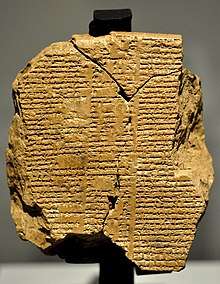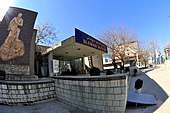Sulaymaniyah Museum
The Sulaymaniayh Museum (Kurdish: مۆزهخانهی سلێمانی; Arabic: متحف السليمانية) is an archeological museum which is located within heart of the city of Sulaymaniyah, Sulaymaniyah Governorate, Kurdistan Region, Iraq. It is also known as Slemani Museum or Sulaimaniya Museum. It is the second largest museum in Iraq, after the National Museum of Iraq in Baghdad in terms of contents. It houses artifacts which date back to the pre-historic period to the late Islamic and Ottoman periods. Several halls of the Museum have undergone renovation work and the Museum was closed to the public for refurbishment from October 1, 2018, to October 2019.
School children are visiting the Sulaymaniyah Museum | |

| |
| Established | July 14, 1961 |
|---|---|
| Location | Sulaymaniyah, Sulaymaniyah Governorate, Kurdistan Region, Iraq |
| Type | Archaeological museum |
| Collections | It houses artifacts which date back to the pre-historic period to the late Islamic and Ottoman periods. |
| Director | Hashim Hama Abdullah |
| Website | http://slemanimuseum.org/ |
History
Opening
The Museum was opened officially on July 14, 1961. Initially, it was composed of a small building in the Shorsh District. After several years, the Museum acquired a new and large building in the heart of Salim Street in the year 1980 CE. The current building has an area of 6000 square meters and is a one-story building. The artifacts are displayed in one small hall (which was recently renovated by the UNESCO) and two large and long halls which are connected by a square-shaped and open lecture hall. During the Iraq-Iran era (1980-1988 CE), the Museum was closed entirely to the public. It was reopened for a very short period in 1990 CE. After the Iraqi invasion of Kuwait in August 1990 CE, the Museum was closed once again. It was re-opened officially by Mr. Jalal Talabani in August 20, 2000 CE; Mr. Talabani was the secretary general of the Patriotic Union of Kurdistan at that time.[1]
Post-2003
After the US-led invasion of Iraq and subsequent looting of the National Museum in Baghdad, The Sulaymaniyah Museum helped to recover and return stolen artifacts through the controversial practice of buying looted artifacts.[2]
UNESCO
Since 2011 CE, the Museum has been collaborating with the UNESCO to develop and renovate the Museum and expand its building.[3]
Paikuli Gallery

The Sulaymaniyah Museum in collaboration with the Sapienza University of Rome opened a new gallery on June 10, 2019. The gallery was sponsored by the Italian Ministry of Foreign Affairs (MAECI) and the Ministry of Cultural Heritage (MiBAC). All of the inscribed stone blocks (including many newly discovered ones after 2006) of the commemorative monument of the Sassanian king Narseh (c., 293 CE) were displayed for the very first time to the public. In addition, many building stone blocks and some Sassanian coins and bullae were also included in this permanent exhibition.[4]
Selmani Museum Kids

On September 5, 2019, the Sulaymaniyah Museum inaugurated a hall dedicated to children and called it "Slemani Museum Kids". The hall has many teaching and demonstrative tools for children. This small museum is the first bespoke museum space for children in Iraq. The Consul General of the UK in Kurdistan, Slemani governor, and director-general of the directorate of archaeology and antiquities in Kurdistan have attended the event, as well as many other high-ranking officials in Kurdistan Region in addition to the public. Slemani Museum Kids was a co-creation of the project Archaeological Practice and Heritage Protection in the Kurdistan Region of Iraq. The project is led by the University of Glasgow (UK) in collaboration with the Slemani Directorate of Antiquities and Inherit (UK) and is funded by the British Council’s Cultural Protection Fund, in partnership with the Department for Digital, Culture, Media, and Sport.[5]
Prehistory Gallery
The Sulaymaniyah Museum renovated two large halls in order to open a new permanent exhibition displaying 100s of artifacts dating back to the prehistoric period. The artifacts mainly came from Iraqi Kurdistan and its Paleolithic caves, in addition to several recently excavated ancient sites and mounds. The project was sponsored by the Embassy of the United States of America. The exhibition was supposed to be opened in early March 2020, but because of the coronavirus pandemic, the inauguration date was deferred.[6]
Gallery
 Tablet V of the Epic of Gilgamesh
Tablet V of the Epic of Gilgamesh Stela of Iddi-Sin, King of Simurrum. It dates back to the Old-Babylonian Period. From Qarachatan Village, Sulaymaniyah Governorate, Iraqi Kurdistan. The Sulaymaniyah Museum, Iraq
Stela of Iddi-Sin, King of Simurrum. It dates back to the Old-Babylonian Period. From Qarachatan Village, Sulaymaniyah Governorate, Iraqi Kurdistan. The Sulaymaniyah Museum, Iraq- Stone block with Paikuli inscription
- "The lady at the window," one of the famous Nimrud ivories' plaques. The Sulaymaniyah Museum, Iraq
- Earrings from Shulgi
 An Inscribed stand's head, early dynastic period
An Inscribed stand's head, early dynastic period- A brick stamped with the name of Ur-Nammu of Ur
 This is one of the two large halls of the Sulaymaniyah Museum
This is one of the two large halls of the Sulaymaniyah Museum This hall was renovated by the UNESCO and was opened in April 2013. It contains most of the Sulaymaniyah Museum masterpieces
This hall was renovated by the UNESCO and was opened in April 2013. It contains most of the Sulaymaniyah Museum masterpieces The Sulaymaniyah Museum, Iraqi Kurdistan
The Sulaymaniyah Museum, Iraqi Kurdistan The Sulaymaniyah Museum, Iraq
The Sulaymaniyah Museum, Iraq The Sulaymaniyah Museum's entrance hall undergoing renovation work, December 3, 2018
The Sulaymaniyah Museum's entrance hall undergoing renovation work, December 3, 2018 Packing pre-historic Mesopotamian artifacts for storage, part of a renovation work. The Sulaymaniyah Museum, December 3, 2018
Packing pre-historic Mesopotamian artifacts for storage, part of a renovation work. The Sulaymaniyah Museum, December 3, 2018 Packing Ur III and Old-Babylonian Mesopotamian artifacts for storage, part of a renovation work. The Sulaymaniyah Museum, December 3, 2018
Packing Ur III and Old-Babylonian Mesopotamian artifacts for storage, part of a renovation work. The Sulaymaniyah Museum, December 3, 2018 Inscribed stone block of Paikuli Tower, Middle Persian and Parthian scripts, at the Sulaymaniyah Museum
Inscribed stone block of Paikuli Tower, Middle Persian and Parthian scripts, at the Sulaymaniyah Museum The new permanent exhibition of Mesopotamian Prehistory, final preparations before official opening
The new permanent exhibition of Mesopotamian Prehistory, final preparations before official opening
References
| Wikimedia Commons has media related to Sulaymaniyah Museum. |
- "History, Slemani museum". www.slemanimuseum.org. Retrieved 16 January 2015.
- "Slemani Museum tires to return stolen artifacts". www.kurdsat.tv. Kurdsat Television. 2011-12-13. Archived from the original on January 4, 2012. Retrieved 16 January 2015.
- "The Museum, Slemani Museum". www.slemanimuseum.org. Retrieved 16 January 2015.
- "Sapienza in Iraq: Italo-Kurdish Collaboration to Protect the Archaeological Heritage of Paikuli". Retrieved 18 March 2020.
- "The Slemani Museum Kids has been opened officially". Retrieved 18 March 2020.
- "Grants". Retrieved 18 March 2020.